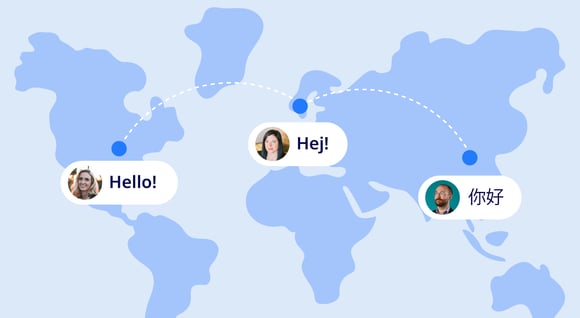Lost in translation? If your workplace language is not your native language, this might be the case from time to time. Maybe you don't fully grasp all the details of your internal employee training at all times. If so, you are not alone.
In fact, language barriers in the workplace impact the effectiveness of learning and development. When we don't understand the learning material fully, it can lead to misunderstandings and hinder knowledge intake and the acquisition of new skills.
Although cultural diversity and multilingualism in the workplace are great in most aspects, it is also something we need to bear in mind when creating learning for our employees.
In this article, we will shed some light on cultural diversity and multilingualism in the workplace and how to minimize the language barrier in your employee learning & training.
But first, we would love to hear about your experience on the topic😄👇
Multilingualism and Cultural Diversity in the Workplace
Workplaces that have an inclusive company culture and embrace cultural diversity tend to, not only attract and retain talent better but also outperform other companies in general.
It has also been shown that organizations with a high degree of multilingualism (the knowledge of knowing more than one language) tend to commit fewer mistakes, increase efficiency, productivity, AND quality.
And no wonder multicultural and multilingual workplaces do so great! Languages give us real superpowers! It gives us the power to communicate and connect with other people. Having a common language opens doors so that we can learn from, share ideas, and our different perspectives with people from all over the world.
At Learningbank, we are proud to have employees of 11 different nationalities. Because of this, all our internal communication is in English. But for most of us, English is our second or even third language.
Want to learn more about how to work with Diversity & Inclusion in your company? Watch our on-demand webinar here.
Language Barriers in the Workplace
Having a culturally diverse workforce that natively speaks different languages, can also create challenges. Especially when you need to train and get your employees to learn new skills, procedures, or safety routines.
Even though many can communicate in their second or third language with a high level and fluency, there are often words, idioms, and phrases that can lead to confusion and miscommunication for non-native speakers.
By reducing language barriers, companies can create a more inclusive and efficient work environment, leading to improved communication, collaboration, and overall job satisfaction among employees.
Importance of Breaking Down the Language Barrier in your Employee Training
Sometimes, miscommunications due to language barriers in employee training can have a huge negative impact. For example, injuries due to misunderstandings in safety training.
The language barrier causing miscommunication can also make it harder to collaborate, customer service might suffer, attracting and retaining talent can become more difficult, and worker safety can get reduced.
According to a study carried out by Forbes and Rosetta Stone, miscommunication due to language barriers contribute to inefficiency in companies by 67%. Additionally, the study shows that 80% of respondents said their workers were more productive when their managers communicated with them in their native language.
These numbers show how important it is to take language into account when creating employee training. For critical topics, it is extra crucial to communicate in your employees' first language to make sure everything is fully understood.
Providing your cultural and language-diverse teams with employee development and learning in their first language has many benefits.
It will not only provide less room for misunderstandings and errors but also increase the feeling of inclusion and being seen.
4 Tips to Overcome the Language Barrier in Your Employee Training
When you work in HR or L&D you often have the responsibility to create learning for all the employees in your company. Maybe you need to provide learning for a huge multinational company or have employees with different native languages?
So how can you reduce the language barriers in the workplace's employee training?
Here are a few tips:
- Translate important employee training. Although cultural and linguistic diversity is great, when we need to retain new information and learn new things, we do it best in our native language. Hence, when it comes to important employee training such as safety training, make sure to get the training translated into all your employees' native languages.
Look for a translation service that can help you with the translations, or use an LMS or learning platform that can do automatic translations directly in the platform. See how auto-translation in Learningbank's platform work here.
It might not always be possible to give employee training in all employees' native languages, but find where it is most crucial and prioritize those training first. - Use visuals and video. Clarifying what you want to teach and convey using more than just spoken or written language will help your learners to understand. Use infographics and other types of visuals to explain complicated topics.
The more ways we can illustrate what we need to communicate, the better and easier it will be for your audience to understand your message. - Use simple language. To make it as clear as possible, use short sentences, stay away from idioms, sarcasm, and complicated or non-common words and phrases.
- Provide language classes. Depending on the size of your company and what kind of work you do, and what your employees do, paying for language classes could be a good investment.
This last one is, of course, not a quick fix. Improving our language skills takes time. But in some cases, this would be the better option.

